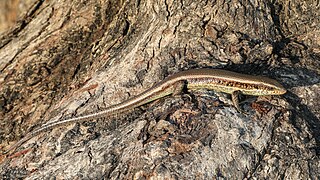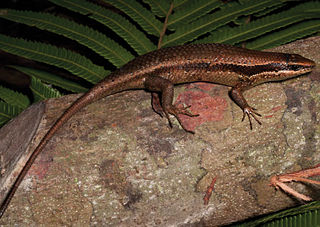
The southern alligator lizard is a common species of lizard in the family Anguidae. The species is native to the Pacific coast of North America. It ranges from Baja California to the state of Washington and lives in a variety of habitats including grasslands, chaparral, forests, and even urban areas. In dry climates, it is likely to be found in moist areas or near streams. There are five recognized subspecies.
Eutropis ashwamedhi, also known commonly as the Ashwamedh supple skink or Ashwamedha writhing skink, is a species of lizard in the family Scincidae. The species is endemic to India.

Eutropis carinata, commonly known as the keeled Indian mabuya, many-keeled grass skink or (ambiguously) "golden skink", is a species of skink found in South Asia.

The bronze grass skink, bronze mabuya or speckled forest skink, is a species of skink found in South and Southeast Asia. It is a common, but shy, ground-dwelling species that is active both day and night.

Eutropis multifasciata, commonly known as the East Indian brown mabuya, many-lined sun skink, many-striped skink, common sun skink or (ambiguously) as golden skink, is a species of skink.

Eutropis tytleri is a species of skink, a lizard in the family Scincidae. The species is endemic to the Andaman Islands, India.

Eutropis is a genus of skinks belonging to the subfamily Mabuyinae. For long, this genus was included in the "wastebin taxon" Mabuya; it contains the Asian mabuyas. They often share their habitat with the related common skinks (Sphenomorphus), but they do not compete significantly as their ecological niches differ. This genus also contains the only member of the subfamily to occur in Australasia, the many-lined sun skink, whose wide range includes New Guinea.
Two-striped mabuya may refer to either of two small skink species formerly placed in the genus Mabuya:
Eutropis madaraszi, also known commonly as the Sri Lanka bronze mabuya, the Sri Lanka bronze skink, or (ambiguously) the spotted skink, is a species of lizard in the family Scincidae. The species is endemic to the island of Sri Lanka.
Eutropis austini is a species of skink, a lizard in the family Scincidae. The species is endemic to Sri Lanka.
Eutropis greeri is a species of skink, a lizard in the family Scincidae. The species is endemic to Sri Lanka.

Eutropis multicarinata is a species of skink found in the Philippines.
Eutropis caraga, the Caraga sun skink, is a species of skink found in the Philippines.
The copper sun skink is a species of skink found in the Philippines.
The upland sun skink is a species of skink found in the Philippines.
The Palawan sun skink is a species of skink found in the Philippines.
The Sibalom sun skink is a species of skink found in the Philippines.
Eutropis resetarii is a species of skink, a lizard in the family Scincidae. The species is endemic to Sri Lanka.
Eutropis alcalai is a species of skink, a lizard in the family Scincidae. The species is endemic to the Philippines.







